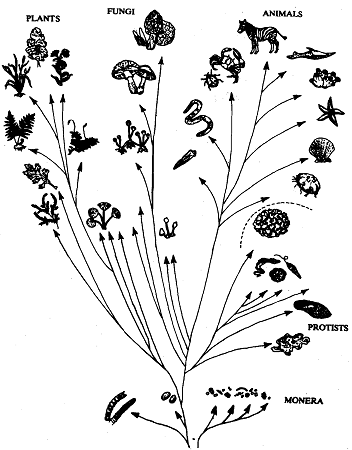Biological evolution
We can presume that biological evolution began with the formation of the first true cells. These must have been forms that did not require free oxygen and lived at the expense of organic molecules available in the waters that surrounded them. Eventually, as nutrients were depleted, tht: first cells capable of using carbon dioxide and energy from light, to make their own food through photosynthesis must have arisen. Today, the diversity of plant and animal forms we have, ranges from simple single celled organisms to many kinds of plants on one side and animals including man on the other. Today, we have millions of 'species' of living forms on our planet. There is evidence, that all the life forms are inter-related and also that the higher forms have evolved from the lower ones. We will study more about this in the next unit-Evolution of Man. The study of these millions of species, individually would be a cumbersome task. Therefore, it is necessary to classify them in groups according to their evolutionary relationships and similarities in form and function.

Today, most biologists recognise five categories or kingdoms of living organisms shown in Fig. The first category, Monera, consists of the most primitive single celled organisms. These alone were present in the beginning for about 2 billion years. These cells do not have a nucleus and are represented today by the bacteria and cynobacteria (formerly known as blue green algae). The second, Protista evolved about 1.5 billion years ago and consists of single celled organisms containing a nucleus. Algae, protozoans and slime moulds belong to this kingdom.
You must have seen mushrooms sprouting under the trees during the rainy season. These, and the unicellular yeast are members of the Kingdom Fungi. They are placed in a separate kingdom because they are one of the most complex organisms that feed on decaying organic matter. Some fungi are also parasitic causing serious diseases in plants, animals and human beings while some fungi have given us the most useful group of medicines-antibiotics. You must have heard about penicillin, streptomycin etc., these are produced by fungi. The next two kingdoms, Plants and Animals, evolved later as a result of adaptations to the changing environment of the earth. Plants began to evolve about 400 million years ago and most of these organisms possess a green pigment, chlorophyll, which helps them in manufacturing their own food by the process of photosynthesis. They first appeared in the seas as unicellular algae. The green algae are believed to be ancestral Links to the land plants like gymnosperms, i.e. nonflowering plants sand angiosperms or flowering plants. Today, these plants have diversified and increased in numbers tremendously.